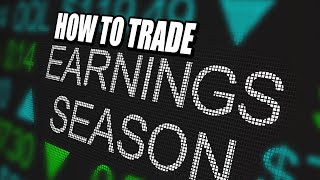How to Trade Around Earnings Season: A Smart Trader's Guide
Earnings season is one of the most exciting and volatile times in the stock market. For traders, it presents a unique mix of opportunity and risk. Companies release their quarterly financial results, and these reports can cause sharp price movements — up or down — in a matter of minutes
But how do you trade smartly around earnings season? Whether you're a beginner or an experienced trader, this guide will help you understand the key strategies, risks, and tools needed to navigate this critical period
When Are the Earnings Seasons?
- Q1 Earnings – April
- Q2 Earnings – July
- Q3 Earnings – October
- Q4 Earnings – January
📈 Why Is It Important for Traders?
Earnings reports can cause sudden and significant price swings. A company that beats expectations can see its stock surge, while a miss can lead to a sharp drop. For traders, this volatility offers high-reward setups — if managed wisely.
⚠️ Risks of Trading Earnings
Before we dive into strategies, it's crucial to understand the risks:
- Gap Risk: Stocks can gap up or down after hours, bypassing your stop loss.
- Unpredictability: Even strong earnings don't guarantee a stock will rise — the market's reaction can be counterintuitive.
- High Option Premiums: Volatility increases option prices, which can eat into your profits if you're not careful.
🧠 Smart Strategies to Trade Around Earnings
1. Avoid Trading Right Before Earnings (Unless You're Speculating)
Trading a stock just before its earnings report is essentially a gamble. If you're not confident in your analysis or don't have an edge, it’s better to wait for the results
Pro Tip: Consider reducing position size or staying on the sidelines until the dust settles.
2. Use Options for Controlled Risk
Options can help you define your risk while benefiting from potential moves.
- Straddle: Buy both a call and a put — useful if you expect a big move but don't know the direction.
- Strangle: Similar to a straddle but with out-of-the-money options — cheaper but requires a larger move.
- Covered Call / Protective Put: For those holding shares, this helps protect from downside or earn income.
3. Trade the Reaction, Not the Event
Some of the best setups happen after earnings are announced. Let the market react and then look for:
- Breakout or Breakdown: Trade continuation in the direction of the move.
- Reversals: If the stock overreacts, watch for a snap-back move.
4. Focus on High-Volume Stocks
Stick to well-known stocks with high liquidity. These tend to have cleaner moves and tighter spreads, which is important when trading around volatile events
5. Use Technical Levels
Combine earnings with chart patterns. Identify key support and resistance zones before earnings are released. These levels often act as magnets or turning points after the results are in
6. Monitor Analyst Reactions
Pay attention to what analysts are saying post-earnings. Upgrades or downgrades can influence price action in the days following the report.
📈 Tools to Use
- Earnings Calendar: Track upcoming announcements (e.g., Investing.com, MarketWatch).
- Option Chain: Gauge implied volatility and potential price movement.
- Pre-market and After-hours Charts: Watch how the stock reacts immediately after earnings.
Final Thoughts
Trading around earnings season can be highly profitable — but only if you have a clear plan and manage your risk. It’s not about guessing whether earnings will beat or miss, but how the market will react. By focusing on reaction rather than prediction, using proper tools, and sticking to a disciplined approach, you can turn earnings season into an opportunity — not a trap.
